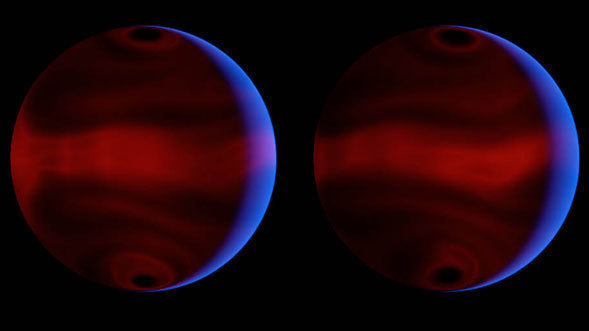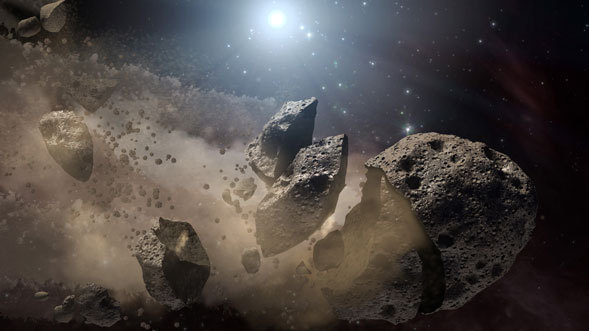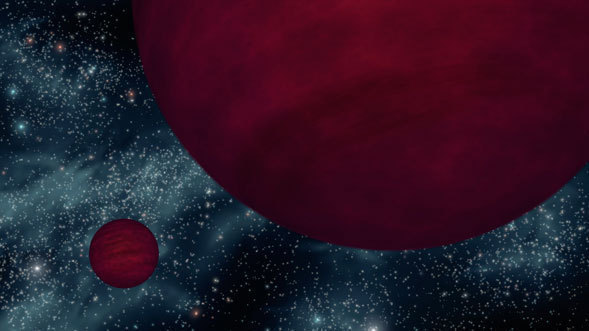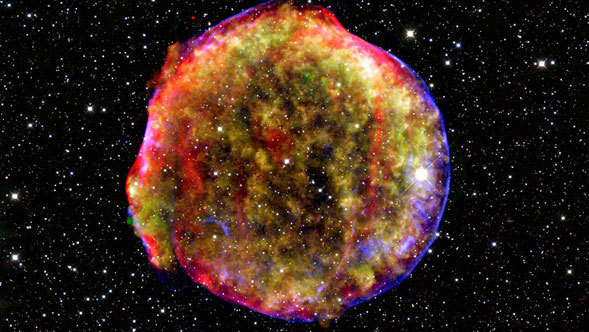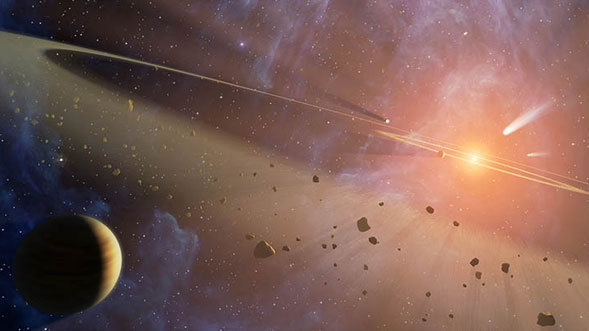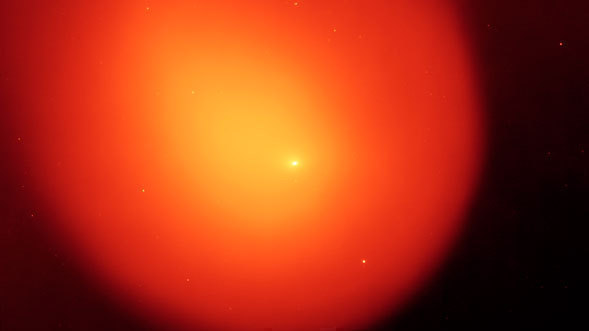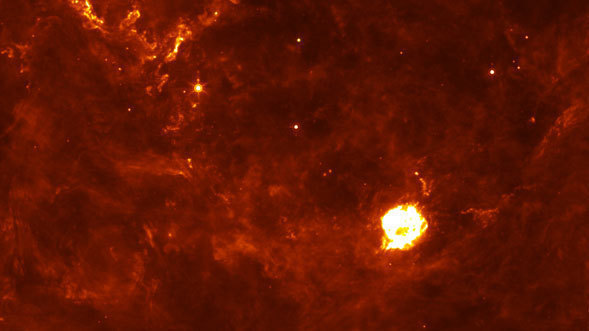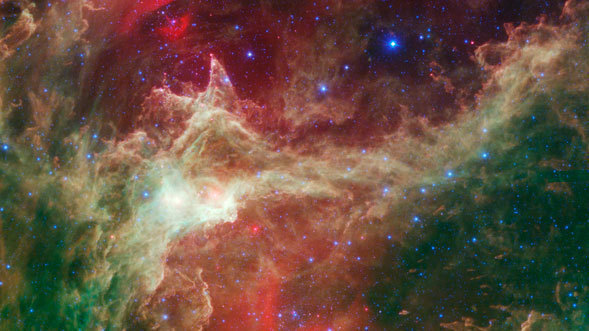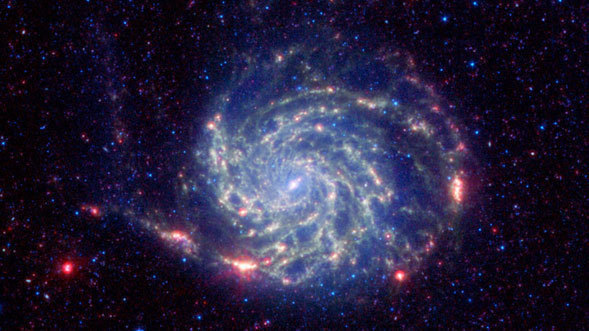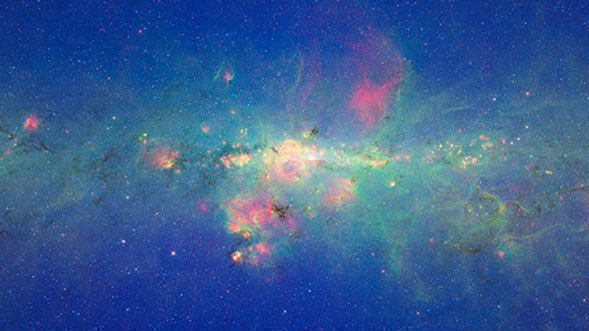Displaying news 331 - 360 of 587 in total
NASA has selected fellows in three areas of astronomy and astrophysics for its Einstein, Hubble and Sagan Fellowships. The recipients of this year's post-doctoral fellowships will conduct independent research at institutions around the country.
NASA's Spitzer Space Telescope has observed a planet that heats up to red-hot temperatures in a matter of hours before quickly cooling back down.
Cornell University
The Chandra X-ray Observatory Center
Astronomers have turned to an unexpected place to study the evolution of planets -- dead stars.
Harvard-Smithsonian Center for Astrophysics
The same way a visible-light photographer can choose to shoot black and white instead of color, astronomers using NASA's Spitzer Space Telescope have their choice of what colors to use or not use in their images, as shown in an image of star-forming region RCW 49 released today.
Some stars have it tough when it comes to raising planets. A new image from NASA's Spitzer Space Telescope shows one unlucky lot of stars, born into a dangerous neighborhood. The stars themselves are safe, but the material surrounding them -- the dusty bits of what might have been future planets -- can be seen blowing off into space.
It's a tie! The new record-holder for dimmest known star-like object in the universe goes to twin "failed" stars, or brown dwarfs, each of which shines feebly with only one millionth the light of our sun.
A new image from NASA's Spitzer Space Telescope shows a turbulent star-forming region, where rivers of gas and stellar winds are eroding thickets of dusty material.
This composite image of the Tycho supernova remnant combines infrared and X-ray observations obtained with NASA's Spitzer and Chandra space observatories, respectively, and the Calar Alto observatory, Spain. It shows the scene more than four centuries after the brilliant star explosion witnessed by Tycho Brahe and other astronomers of that era.
Shock waves around dusty, young stars might be creating the raw materials for planets, according to new observations from NASA's Spitzer Space Telescope.
New observations from NASA's Spitzer Space Telescope indicate that the nearest planetary system to our own has two asteroid belts. Our own solar system has just one.
When comet Holmes unexpectedly erupted in 2007, professional and amateur astronomers around the world turned their telescopes toward the spectacular event. Their quest was to find out why the comet had suddenly exploded.
This painterly portrait of a star-forming cloud, called NGC 346, is a combination of multiwavelength light from NASA's Spitzer Space Telescope (infrared), the European Southern Observatory's New Technology Telescope (visible), and the European Space Agency's XMM-Newton space telescope (X-ray).
Our current view of the universe, to quote Albert Einstein, is "not weirder than we do imagine, but weirder than we can imagine." That said, we have no choice but to observe the universe through human eyes and brains. How can we even start to make sense of it?
RCW 108 is a region where stars are actively forming within the Milky Way galaxy about 4,000 light years from Earth. This is a complicated region that contains young star clusters, including one that is deeply embedded in a cloud of molecular hydrogen. By using data from different telescopes, astronomers determined that star birth in this region is being triggered by the effect of nearby, massive young stars.
Hot spots near the shattered remains of an exploded star are echoing the blast's first moments, say scientists using data from NASA's Spitzer Space Telescope.
Podcasting -- producing audio & video content for computers and mobile devices -- has grown in popularity over the past several years. NASA's Spitzer Space Telescope hit a new milestone in August: 7 million downloads of its various podcasts.
Water is being blasted to pieces by a young star's laser-like jets, according to new observations from NASA's Spitzer Space Telescope.
Take leading artists and scientists from all over the Pasadena area, put them in the great outdoors on a lovely late summer evening, and you've got TERRA-BYTE, an interactive celebration of art and science a the Los Angeles Arboretum. Combining "TERRA" as in the planet earth and "BYTE" a unit of storage in computers, TERRA-BYTE creates a platform to explore the natural world through art, science, and emerging technology within the beautiful gardens of The Arboretum. From 5:30 to 9:30 pm, this Sunday, 9/14/2008, visitors will enjoy live music, garden tours, refreshments and interactive exhibits including an infrared camera at the Spitzer Space Telescope booth.
A new image from NASA's Spitzer Space Telescope tells a tale of life and death amidst a rich family history. The striking infrared picture shows a colorful cosmic cloud, called W5, studded with multiple generations of blazing stars.
Los Angeles' Griffith Observatory will host an event on August 22-24, 2008 to celebrate the fifth anniversary of NASA's Spitzer Space Telescope. The Spitzer mission has shown us incredible new views of the universe in infrared light, which can be thought of as "night vision" or "heat" light. Spitzer's accomplishments include imaging the farthest galaxy yet seen, multiple breakthroughs in our understanding of the lives of stars and the first detection of light coming from planets orbiting other stars.
New evidence from NASA's Spitzer Space Telescope reveals that most galaxies undergo a huge stellar baby boom when they first enter a "cosmic city", or galaxy cluster. And the more distant the galaxy cluster, the greater the star formation rate.
The Pinwheel galaxy is gussied up in infrared light in a new picture from NASA's Spitzer Space Telescope.
A contender for the title of brightest star in our Milky Way galaxy has been unearthed in the dusty metropolis of the galaxy's center. The Spitzer Space Telescope is a NASA mission managed by the Jet Propulsion Laboratory. This website is maintained by the Spitzer Science Center, located on the campus of the California Institute of Technology and part of NASA's Infrared Processing and Analysis Center. Privacy Policy
Astronomers have uncovered an extreme stellar machine -- a galaxy in the very remote universe pumping out stars at a surprising rate of up to 4,000 per year.
When amateur astronomer Ron Arbour spotted an enormous explosion from 17 million light-years away in the Fireworks Galaxy (NGC 6946), many professional scientists believed that it was the final death throes of a massive dying star. However, observations from NASA's Spitzer Space Telescope unexpectedly showed that a relatively lightweight star was the source of this spectacular blast.
More than 800,000 snapshots from NASA's Spitzer Space Telescope have been stitched together to create a new "coming of age" portrait of stars in our inner Milky Way galaxy.
Displaying news 331 - 360 of 587 in total

